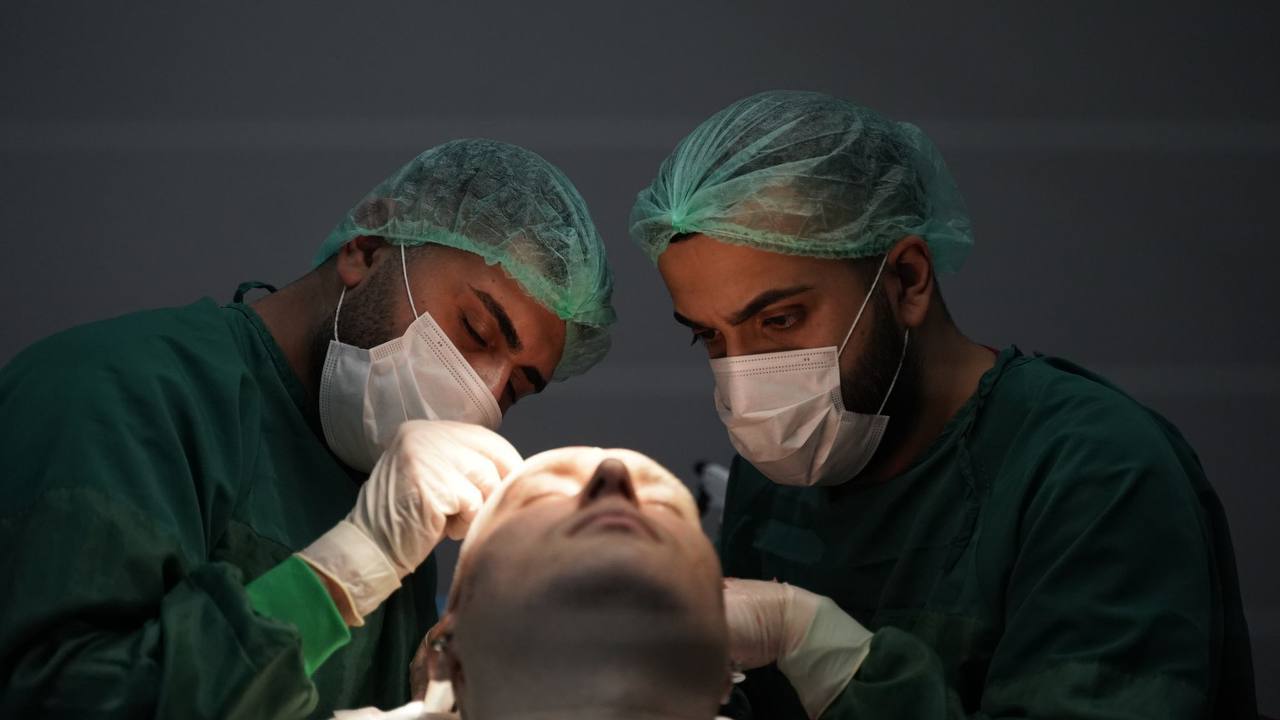Anyone considering hair transplant surgery immediately faces complete chaos: dozens of techniques, hundreds of clinics, thousands of contradictory reviews. One doctor says one thing, another says the complete opposite. You hear bold promises, but no real guarantees are discussed.
In this flood of information, it's easy to get confused. Especially when you understand that what's at stake isn't just money, but your appearance, self-confidence, and comfort for years to come. The wrong clinic choice can lead to disappointment, repeat surgery, and wasted time.
The good news is that smart, calm decision-making is possible. You just need to understand how to choose a hair transplant clinic consciously: without rushing, based on facts, with clear questions and focus on the result you actually need.
To help on this journey, we've gathered the most important criteria, signs of reliable clinics, a list of questions for doctors, and typical mistakes that are easy to avoid when you know what to look for.
In this flood of information, it's easy to get confused. Especially when you understand that what's at stake isn't just money, but your appearance, self-confidence, and comfort for years to come. The wrong clinic choice can lead to disappointment, repeat surgery, and wasted time.
The good news is that smart, calm decision-making is possible. You just need to understand how to choose a hair transplant clinic consciously: without rushing, based on facts, with clear questions and focus on the result you actually need.
To help on this journey, we've gathered the most important criteria, signs of reliable clinics, a list of questions for doctors, and typical mistakes that are easy to avoid when you know what to look for.
Where to Start When Choosing a Clinic
Diagnosis as the First Step
This is the most common and simultaneously most dangerous mistake. People start their journey by choosing a clinic or method, skipping diagnosis entirely. Good service always begins with assessment: online or in-person. It's at this stage that the following is determined:
Based on this data, a personalized treatment plan is formed. Without it, both doctor and patient are literally acting blindly, which almost always leads to mistakes and disappointments.Get a diagnosis with an experienced trichologist to clearly understand what solution you specifically need.
- stage and type of alopecia (for example, according to the Norwood or Ludwig scale);
- density and condition of the donor area, including the back of the head and temples;
- preliminary calculation of graft volume and distribution by zones;
- prognosis for density and survival rate in your specific case.
Based on this data, a personalized treatment plan is formed. Without it, both doctor and patient are literally acting blindly, which almost always leads to mistakes and disappointments.Get a diagnosis with an experienced trichologist to clearly understand what solution you specifically need.
Defining Goals and Expectations
The goal of hair transplantation isn't simply to "cover bald spots," but to achieve a result that matches your appearance type, lifestyle, and expectations. That's why it's important to discuss with your doctor in advance:
Clearly formulated goals help the doctor create an understandable and realistic plan. And you'll be confident you're moving in the right direction, without vague promises.
- what hairline shape and height you want (considering forehead anatomy and age);
- whether you're aiming for high density in one area or even improvement across the entire head;
- whether you're ready to undergo multiple stages (for example, transplant plus touch-up after a year);
- which areas are priority for you: just the front, crown area, or everything at once;
- how important natural effect is to you, considering hair structure and growth direction.
Clearly formulated goals help the doctor create an understandable and realistic plan. And you'll be confident you're moving in the right direction, without vague promises.
Budget and Timeline
Hair transplant prices can start from $1000 and reach $10000 and higher. Everything depends on the country, clinic level, doctor's experience, and service composition. But the amount by itself doesn't tell you anything. High price doesn't guarantee quality, and low price doesn't always mean poor results. It's important to understand what exactly is included in the cost.
Check:
Clinics with low prices often cut costs on support, sterility, or staff. Find out what the offer is based on.
Timeline for results is another frequent source of disappointment. First noticeable changes become visible after 6-9 months, but complete recovery and final density form by 12-18 months. Don't expect immediate effects. This journey requires patience, and a good doctor should explain timeframes and stages in advance.
Check:
- whether initial diagnosis and consultation are included;
- who exactly will perform the key stages of the operation: doctor or assistants;
- whether transfer, accommodation, translation, and meals are provided (especially relevant abroad);
- whether post-operative care products are provided;
- whether there's a schedule for checkups and photo reports;
- whether you can contact the doctor or coordinator at any time.
Clinics with low prices often cut costs on support, sterility, or staff. Find out what the offer is based on.
Timeline for results is another frequent source of disappointment. First noticeable changes become visible after 6-9 months, but complete recovery and final density form by 12-18 months. Don't expect immediate effects. This journey requires patience, and a good doctor should explain timeframes and stages in advance.
💬 If you don't fully understand what you need in your case yet, start with a free consultation. At iHairium, we'll analyze your situation, determine an accurate diagnosis, suggest suitable methods, and explain what a real plan looks like, without guesswork.

Criteria for Choosing Clinic and Doctor
After initial diagnosis, it's important to understand the details. The choice doesn't come down to price or clinic popularity. The key question is what to look for when choosing a clinic so you won't regret it later. Here, not only doctors and methods matter, but also process transparency, document availability, support, and real cases.
Licenses and Documents
The first step is to verify the official status of the clinic and doctors. In the country where surgery is planned, the clinic must have a valid medical practice license. This means the institution undergoes inspections, follows safety standards, and has the right to perform surgical procedures.
What's important to clarify:
This isn't formality, but basic guarantee that you're turning to a legal, verified institution.
What's important to clarify:
- Does the clinic have a valid license? Who issued it?
- Is the license profile specified (for example, surgical activity or dermatology)?
- Does the doctor have international certificates confirming experience specifically in hair transplantation?
- Is the clinic a member of professional associations (for example, ISHRS)
This isn't formality, but basic guarantee that you're turning to a legal, verified institution.
Doctor's Specialization and Experience
The final result is hugely influenced not by the clinic's brand or its interior, but by the doctor who performs the operation. If you want to understand how to verify doctor qualifications, ask yourself several simple questions:
If answers to these questions are clear and convincing, this is already a sign of professionalism and quality.
- Does the doctor specialize specifically in hair transplantation, rather than just offering it as one of many services?
- How many years have they worked in this direction and how many operations have they performed?
- Do they perform procedures regularly (8 to 15 transplants per month is considered good practice)?
- Do they master several techniques and know how to select them for specific tasks?
- Do they personally participate in key procedure stages (marking, graft harvesting and implantation)?
If answers to these questions are clear and convincing, this is already a sign of professionalism and quality.
Portfolio and Clinic Reputation
One of the most reliable confirmations of quality is cases, reviews, and real patient history.
Learn to distinguish marketing from real proof of success and experience. A beautiful Instagram isn't a result yet.
- "Before and after" photos at 6, 9, and 12 months, when you can judge the final result.
- Cases similar to yours. This helps evaluate how well the doctor handles tasks similar in hair type, alopecia zone, and expected density.
- Video or written reviews with specifics. Details matter, not emotions: how many grafts were transplanted, how recovery went, what the plan was.
- Where are reviews published? Trust is higher for independent sources: specialized forums, YouTube, Telegram communities. If all activity is only on the clinic's website, it's worth double-checking authenticity.
Learn to distinguish marketing from real proof of success and experience. A beautiful Instagram isn't a result yet.
Post-operative Support: What Happens After Surgery
Transplantation doesn't end when you leave the operating room. Key processes happen afterward: graft survival, recovery, hair growth, and complication prevention. So clarify:
- Is there a checkup schedule and regular photo reports? Who evaluates progress - doctor or coordinator?
- Are care products and instructions provided? What's included: shampoos, foams, serums?
- Is contact with doctor or coordinator provided when alarming symptoms appear?
- Are lifestyle recommendations given: sleep, nutrition, headwear, sports?
- How long does observation last: 1 month, 3 months, or the entire year?
Conditions, Service and Support
Transplant quality is determined not only by the medical part, but by the entire system around it. Comfort, safety, and organization level affect overall impression and patient peace of mind.
Does support include care product kit and detailed instructions: how to wash hair, how to sleep, what to do with swelling and itching.
- Is modern equipment used: microscopes, sapphire instruments, magnification systems.
- Are international sterility and safety standards followed: individual packages, disposable supplies, infection control.
- Is logistics organized: transfer, accommodation, meals, translator for foreign patients.
- Is there a coordinator or accompanying specialist who guides the patient from consultation to post-operative stage.
- How is post-operative monitoring arranged: photo report schedule, consultations, complication response.
Does support include care product kit and detailed instructions: how to wash hair, how to sleep, what to do with swelling and itching.

Price Transparency and Package Composition
When it comes to hair transplantation, price by itself says little. The same budget can include a minimal service set or comprehensive support with diagnosis, logistics, and post-operative care. Don't just ask about the amount, but understand what you're paying for.
What to clarify:
A complete, transparent package most often includes:
The more detailed your understanding of cost structure, the easier it is to compare clinics and the less chance of unpleasant surprises.
What to clarify:
- What's included in the base cost? (diagnosis, accommodation, translation, medications, meals)
- Are additional payments possible: for extra grafts, repeat examination, medications?
- How is payment structured: advance, payment upon completion, installment possibility?
- Is there a written estimate or contract with clear service list?
A complete, transparent package most often includes:
- diagnosis and doctor consultation;
- individual transplant plan;
- the procedure itself with designated stages and technique;
- hotel accommodation, transfer and translation;
- care product kit and instructions;
- photo reports, checkups and support for several months.
The more detailed your understanding of cost structure, the easier it is to compare clinics and the less chance of unpleasant surprises.
💡 At iHairium, we personally check every clinic we work with. We have an internal checklist with dozens of criteria. We examine everything from licenses and conditions to how doctors support patients after surgery. We don't just read reviews. We visit locations, talk with doctors, observe processes. See how this works in practice in one of our video reprots.
How Not to Make Mistakes: Red Flags
To choose a hair transplant clinic and avoid unpleasant situations, it's important to recognize warning signals even at the consultation stage. Here are signs that may indicate the clinic in front of you isn't the most reliable:
❌ Unlimited promises. "100% survival rate," "unlimited number of grafts," "perfect result guaranteed" - such statements sound nice but in reality aren't supported by clinical practice. Conscientious doctors speak in terms of probabilities and individual prognoses.
❌ Lack of process clarity. It's unclear who exactly will perform the operation, what stages are included in the package, when and what will happen? This is reason for concern. A good clinic provides a detailed step-by-step plan.
❌ Questionable reviews and cases. Frequent signals that there aren't enough real confirmed cases: If photos are only on the website, results after 6-12 months are absent.
❌ General formulations and vague answers. Direct questions like "how many grafts?", "who does implantation?", "what's included in the cost?" should be answered just as directly. Otherwise there's no transparent structure.
❌ Lack of clear documentation. A reliable clinic formalizes the treatment plan in writing: graft volume, transplant zones, method, prognosis and date. If this is all just "verbal" - the risk is high.
❌ Same approach for everyone. When consultation immediately offers the same method without understanding the task, you're put into a standard flow. Individual approach is mandatory in hair transplantation.
Notice even 2-3 flags? Better think twice and consider alternatives.
❌ Unlimited promises. "100% survival rate," "unlimited number of grafts," "perfect result guaranteed" - such statements sound nice but in reality aren't supported by clinical practice. Conscientious doctors speak in terms of probabilities and individual prognoses.
❌ Lack of process clarity. It's unclear who exactly will perform the operation, what stages are included in the package, when and what will happen? This is reason for concern. A good clinic provides a detailed step-by-step plan.
❌ Questionable reviews and cases. Frequent signals that there aren't enough real confirmed cases: If photos are only on the website, results after 6-12 months are absent.
❌ General formulations and vague answers. Direct questions like "how many grafts?", "who does implantation?", "what's included in the cost?" should be answered just as directly. Otherwise there's no transparent structure.
❌ Lack of clear documentation. A reliable clinic formalizes the treatment plan in writing: graft volume, transplant zones, method, prognosis and date. If this is all just "verbal" - the risk is high.
❌ Same approach for everyone. When consultation immediately offers the same method without understanding the task, you're put into a standard flow. Individual approach is mandatory in hair transplantation.
Notice even 2-3 flags? Better think twice and consider alternatives.
How to Make a Smart Clinic Choice
Even knowing basic criteria, many still experience doubts. To avoid spontaneous decisions and not fall for marketing, it's important to come prepared: with a clear list of questions, expectations, and selection criteria.
Ask Smart Questions to the Doctor During Consultation
Properly selected questions to ask doctor before hair transplant allow you to understand clinic level, approach and avoid misunderstandings in advance:
Checklist: Signs of a Good Hair Transplant Clinic
✅ clinic license and doctor documents
✅ clear treatment plan before payment
✅ cases with similar patients after 6-12 months
✅ doctor participates personally
✅ detailed consultation before procedure
✅ post-operative support
✅ clear estimate without "surprises"
✅ transparent methodology, choice justification
✅ real reviews outside the website
Hair transplant clinic quality is demonstrated not by advertising and beautiful interiors, but by systematicity, openness, and real experience working with patients with tasks similar to yours.
Ask Smart Questions to the Doctor During Consultation
Properly selected questions to ask doctor before hair transplant allow you to understand clinic level, approach and avoid misunderstandings in advance:
- Who does the marking, harvesting, graft implantation?
- What transplant method will be used and why?
- How many grafts will be needed?
- What's the survival rate prognosis?
- Which areas will be treated?
- Is there quality control and who's responsible for results?
Checklist: Signs of a Good Hair Transplant Clinic
✅ clinic license and doctor documents
✅ clear treatment plan before payment
✅ cases with similar patients after 6-12 months
✅ doctor participates personally
✅ detailed consultation before procedure
✅ post-operative support
✅ clear estimate without "surprises"
✅ transparent methodology, choice justification
✅ real reviews outside the website
Hair transplant clinic quality is demonstrated not by advertising and beautiful interiors, but by systematicity, openness, and real experience working with patients with tasks similar to yours.

Choose Your Clinic with Confidence
Good hair transplantation starts with smart choice of who performs it. Not random, not emotional, but systematic. A reliable clinic always honestly answers, shows, explains, and supports.
Choice starts with questions, continues with detail analysis, and ends with calm confidence: you understand who you're trusting, why, and how it will happen.
At iHairium, we don't limit ourselves to one clinic and don't sell others' promises. Our task: give you access to verified options, transparent information, and expert support so you can make an informed decision without risking blindly.
➡️ Get diagnosis and receive transplant plan
In hair transplantation, much depends on choice, and the better prepared you are, the higher the chance this journey will go smoothly, effectively, and without unnecessary disappointments.
Choice starts with questions, continues with detail analysis, and ends with calm confidence: you understand who you're trusting, why, and how it will happen.
At iHairium, we don't limit ourselves to one clinic and don't sell others' promises. Our task: give you access to verified options, transparent information, and expert support so you can make an informed decision without risking blindly.
➡️ Get diagnosis and receive transplant plan
In hair transplantation, much depends on choice, and the better prepared you are, the higher the chance this journey will go smoothly, effectively, and without unnecessary disappointments.










